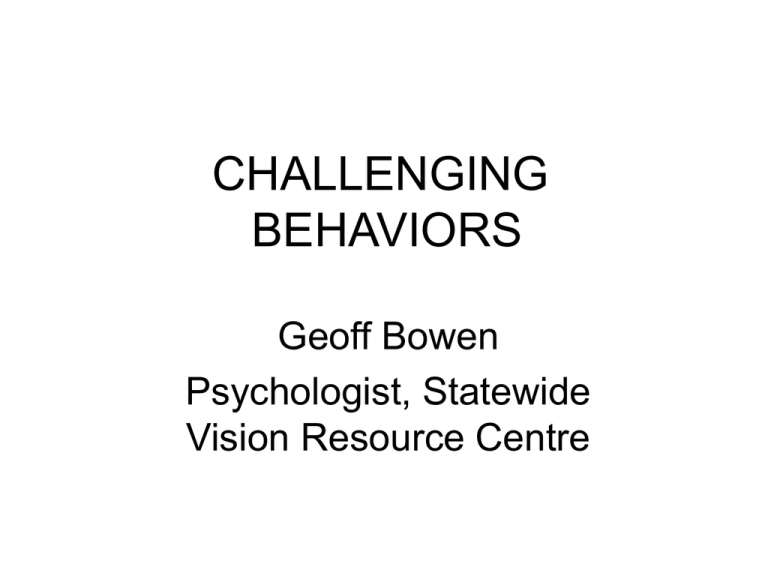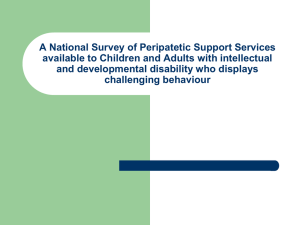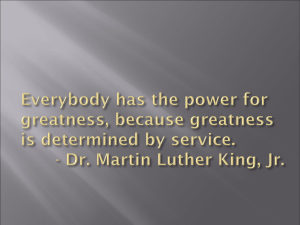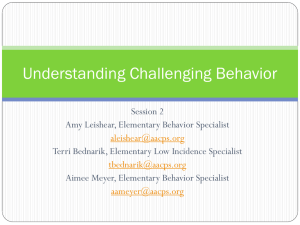Management of challenging behaviors
advertisement

CHALLENGING BEHAVIORS Geoff Bowen Psychologist, Statewide Vision Resource Centre “You cannot solve the problem with the same kind of thinking that has created the problem.” Albert Einstein Aim Of Presentation Discuss important issues in dealing with students with challenging behaviors. With reference to students with vision impairment and multiple disabilities. Topics 1. 2. 3. 4. 5. 6. 7. Vision impairment and multiple disabilities. What is challenging behavior? The maintenance of your own emotional control as a basis to effective management techniques. Quality of life of students. The distinction between support and discipline. A positive, school based systems approach to promoting behavior change. Functional Behavioral Analysis and Assessment. The use of drugs in assisting students with challenging behavior. • • • • • • Intellectual Disability: ID Autism Spectrum Disorder: ASD Self Injurious Behaviour: SIB Pervasive Developmental Disorder: PDD Attention Deficit Disorder: ADD Attention Deficit Hyperactive Disorder: ADHD • Behaviour of Concern: BoC • Psychotropic Medications: PM V I & Multiple Disabilities • Vision impairment has multiple causes. • A number of students with vision impairment have multiple disabilities (physical and intellectual disabilities) and display challenging behaviors (minority of people with intellectual disabilities: 6.1% - Emerson, 1995). Vision, ID, ASD and Psychopathology • Approximately 75% of visual impairments result from some problem with aspects of the central nervous system. • 60-70% of children with visual impairments will ultimately be diagnosed as having a secondary disability. • 50% of blind students have a learning disability. Of those with moderate to severe (i.e. IQ 50 or less) LD 56% have autism. • Prevalence of mental illness in persons with ID is greater than that for the general population (4 - 5x higher) • Range from 30 -70% of the ID population with a mental illness (sampling issues, diagnostic criteria and assessment procedures account for variability). • 2 -10% have a serious mood disorder; 50% suffer from dysthymic or depressive disorder • 10% with ADD; 10 - 25% with anxiety disorder • Schizophrenia 2-3x higher than that reported in the general population • SIB 10 - 20%; stereotyped behaviour 15 - 50% • 75% of individuals with ASD have a intellectual disability and usually significant BoC • Rinck (1998) 12 and 43% of persons with ID take PM Disability And Behavior Typical behavior management strategies may be less effective with students who have pervasive developmental delays because of: • • • • Severe communication difficulties. Poor understanding of social expectations. Motivational differences. Greater prevalence of psychiatric neurological and disorders. • Cognitive processing delays. • Sensory deficits particularly hearing and vision. • Pervasive self reinforcing self stimulatory behaviours. Challenging Behaviors “Behaviors of such intensity, frequency or duration that the physical safety of the person or others are placed in serious jeopardy, or behavior which seriously limits the person’s access to ordinary settings, activities and experiences.” Emerson et al 1988 Challenging Behaviors “It was originated by advocates of people with disabilities who were tired of terms like "behavior disorder", "disturbed behavior", "inappropriate behavior" and "behavior problem". They argued that such terms wrongly attributed ownership and blame to the person, as if they carried the behavior around as "symptoms" of their disability. Instead, the advocates argued, their behavior was a very understandable response to often unstimulating, inflexible, dehumanising and unresponsive services. Their behaviors in fact represented " symptoms " of a " sick system " and in this way "challenged" the system to improve and to become more responsive.” Radler 1990 Types Of Challenging Behaviors • • • • • • • • • • Running away Fears, Anxiety, Phobias and Panic Problems with Transitions Indiscriminate Arousal Lack of Motivation Sleep Problems Depression and other Mental Health Problems Rituals/Obsessions Total Withdrawal Aggression/Destructive Behavior/Self Injury Emotional Control The first step in managing challenging behaviors is learning to manage yourself, particularly your stress and emotions when a student displays a behavior that you find stressful. Managing Yourself The challenge of “challenging behavior” is to look at our behavior first and ask am I managing myself effectively? Is what I am saying to myself and doing in my best interest and is it helping the student learn what to do? Remember the worst judge of what you are actually doing in the classroom may be yourself! Rules To Promote Rational Thinking • It doesn’t do anything to me. The situation doesn’t make me angry, anxious or afraid. I say things to myself that produce anger, anxiety or fear. • Everything is exactly the way it should be. The conditions for things to be otherwise don’t exist. To say that things should be other than what they are is to believe in magic. They are the way they are because of a long series of causal events, including interpretations, responses from irrational self-talk etc. To say things should be different is to throw out causality. • All humans are fallible creatures. This is inescapable. If you haven’t set reasonable quotas of failure for yourself and others, you increase the prospects for disappointment and unhappiness. It becomes all too easy to attack yourself and others as worthless, bad etc. • It takes two to conflict. Before beginning a course of accusation and blame, consider the 30% rule. Any party to a conflict is contributing at least 30% of the fuel to keep it going. • The original cause is lost in antiquity. It is a waste of time who did what first. The search for the original cause of chronic painful emotions is extremely difficult. The best strategy is to make decisions to change your behaviour now. • We feel the way we think. This is the positively stated principle behind the first statement on the list. It reinforces the idea that events don’t cause emotions – our interpretation of events causes emotions. Quality Of Life In recent years there has been a movement for the guiding principle about catering for students with challenging behaviors to consider helping that student and their families to have the best quality of life possible. Quality Of Life “ Children with a disability can lead positive, happy lives and bring joy to themselves and many people. Quality of life is not about ability - we all have different abilities. Quality of life is about your child feeling well, being safe and comfortable, having experiences to enjoy, feeling that she is a lovable person, and having some things that she can feel proud of being able to do.” ( Disabilities: www.cyh.com/HealthTopics/ ) Geoff’s Big Four For Carer Sanity 1. 2. 3. 4. To sleep through the night. To be toilet trained. To be able to occupy themselves without doing damage to themselves, others or property. To be able to go to public places with carers and remain relatively unobtrusive. Discipline Vs Support The general approach to dealing with student’s behavior has been based on a discipline model rather than a support model. (Robert Cooke Promoting Positive Student Behavior, 1999. Discipline “Discipline is usually thought of as with rules established for the common good. The goal is to eliminate or reduce the likelihood of inappropriate and non-compliant behavior. As such, "discipline" is about the sophisticated idea of learning what not to do.” Support “Support is about teaching the student what to do. First it is about supporting the student in working out what is wanted or what is wrong given the context and situation. Whenever possible, the student is then provided or assisted to obtain what is wanted.” Discipline & Support • • Discipline generally leads to emotional distancing between the teacher and the student. With Support relationships are strengthened and the teacher becomes part of the solution to the student's problems. Practical Objections To Punishment • Ineffective in the long run. • Causes unwanted side effects e.g. fear. • Indicates what not to do rather than what to do. • Justifies inflicting pain. • Relates only to particular situation of punishment. • Elicits aggression towards punisher or others. • Replaces one undesirable behavior with another. School Based Systems Approach The following gives ten key features of a systematic, positive, school-based approach to promoting behavior change developed by Robert Cooke in consultation with a team of teachers in Victorian schools and outlined in Promoting Positive Student Behavior, 1999 Working together: the school leaders takes responsibility for forming a team to work together with, and support teachers in all aspects of planning and intervention. The team includes people who do not have daily contact with the student. The team monitors teacher needs, tailoring support according to concerns and aspirations. Proactive: the school accepts responsibility for change and sets realistic goals and plans, acting on the belief that positive outcomes will be achieved while continuing to manage setbacks that occur. This requires establishing and acting on both short and long-term objectives at the same time within a context of constant review. Promotion: the whole school, including staff other than teachers, is alert to opportunities to recognise accomplishment and promote appropriate, positive behavior and the skills and competencies the student has already. Prevention: the school makes changes and actions to prevent or reduce the likelihood of problem events occurring or escalating to a crisis. Communication: it is recognises that components of problem behavior include adaptive attempts to communicate that have gone wrong due to restricted student ability, faulty learning and limitations of the environment. These adaptive attempts have real meanings, may be appropriate and urgent on some occasions, and have different meanings as circumstances change. Multiple influences: there is acceptance that multiple influences contribute and interact to maintain the problem behavior; there is rarely a single causal factor. This requires a comprehensive investigation, analysis and monitoring of variables rather than single-point assessment of the student or the behavior. Systematic process: the school action plan for managing challenging behavior is an individualised, sustained process using multiple, systematic strategies; it is not a curriculum or discipline package. Strategies and plans are managed in the social context and through the regular curriculum activities planned for all students. All aspects of the plan are clearly documented and distributed and discussed with all staff. Systematic process: the school action plan for managing challenging behavior is an individualised, sustained process using multiple, systematic strategies; it is not a curriculum or discipline package. Strategies and plans are managed in the social context and through the regular curriculum activities planned for all students. All aspects of the plan are clearly documented and distributed and discussed with all staff. Instructional focus: strategies include curriculum change, positive programming, and gently teaching alternate behaviors, new patterns of social skills and meaningful interaction based on trust. New skills with replacement value are taught before the student can be expected to no longer need the problem behavior. Addressing life-style issues: interventions address changing a range of lifestyle, environmental and school issues to put the student at advantage in both present and future settings. Behavioral Interventions Quality Assurance Issues 1. 2. 3. 4. 5. Does the behavior warrant intervention? Have the physical/psychiatric aspects of the behavior been assessed? Have the situational aspects of the behavior been assessed? Has the function of behavior been determined? Have systematic influences on behavior been determined? Have the assessments led to a diagnostic hypothesis? 7. Is the recommended intervention consistent with the diagnostic hypothesis? 8. Is the intervention the least intrusive/restrictive option? 9. Is the intervention "crisis intervention" or "therapeutic intervention?" 10. Has student (parent) provided informed consent for the intervention? 11. Are the effects and side effects of the intervention monitored? 6. 12. What is the time limit of the intervention? 13. Is the intervention given an adequate treatment trial? 14. Is there increasing escalation of behaviour intervention? (Adapted from Griffiths 1989 by Dr Stewart McDonald and Dr Linda McDonald, 1993) Functional Behavioral Analysis (FBA) Functional analysis -- systematic observation to determine the function served by challenging behavior, the consequences that maintain it, and the circumstances that occasion it -- should be an ongoing process. Once is not enough! The Professional Advisory Committee National Down Syndrome Congress January, 1990 The Rationale Behind FBA • Practically all behavior serves a purpose: it allows students to “get” something desirable, “escape” or “avoid” something undesirable, or communicate some other message or need. • Behavior occurs within a particular context. It may occur in certain settings (e.g. in the gym), under certain conditions (e.g. only when there is a substitute teacher), or during different types of activities (e.g., during recess). • Students will change the inappropriate behavior only when it is clear to them that a different response will more effectively and efficiently accomplish the same thing. • Therefore identifying the causes of a behavior— what the student “gets,” “escapes,” or “avoids,” or is attempting to communicate through the behavior—can provide the information necessary to develop effective strategies to address those behaviors that interfere with learning or threaten safety. Why do a Functional Assessment and Analysis? • Prevents intervention constructed around ‘surface level’ behaviour only. • Assists in altering interventions from reactive to proactive. • Collaborative development lessens chance of locating ‘blame’ on one person. • Provides opportunity to see situations from other points of view - and emotions. Functional Behavioral Assessment (FBAs) • A FBAs is a problem-solving process that relies on a variety of techniques and strategies to identify the purposes of specific behaviour. • The assessment helps in the selection of interventions to directly address the problem behaviour. (Quinn et al., 1998, p. 3) Functional Analysis • A functional analysis is the manipulation of antecedents and consequences based on information gathered during the functional assessment. • Analysis of behaviour throughout a functional assessment leads to the development of a hypothesis about the function of a behaviour. Overview Of FBA • • • • • • Collect information Describe the behavior Determine the functions of behavior Develop a plan of intervention Implement the plan correctly Evaluate the outcome of the plan Functional Behavioral Assessment 1. Describe and verify the seriousness of the problem. 2. Refine the definition of the problem behavior 3. Collect information on possible functions of the problem behavior. 4. Analyze information using data triangulation and/or problem pathway analysis. 5. Generate a hypothesis statement regarding the probable function of the problem behavior. 6. Test the hypothesis statement regarding the function of the problem behavior. FBA A Method for Developing, Implementing and Monitoring a behavior Intervention Plan: 7. Develop and implement a behavioral intervention plan. 8. Monitor the faithfulness of implementation of the plan. 9. Evaluate effectiveness of the behavior intervention plan. 10. Modify behavior intervention plan, as needed. CREATING POSITIVE BEHAVIORAL INTERVENTION PLANS AND SUPPORTS Robert A. Gable et al 2000 Functional Behavior Assessment (Description) • • • • • • • • Data Sources Describe behavior Settings Frequency Intensity Duration Describe previous interventions Educational impact Emphasis On Proactive Strategies Ecological Interventions Positive Programming Focused Intervention Strategies Less Emphasis on Reactive Strategies (mainly for incident management) (Donnellan, LaVigna, Zambitto, Thvedt, 1985; LaVigna & Willis, 1995; LaVigna, Willis,& Donnellan, 1989; Willis & LaVigna,1995). • Ecological Interventions: creating a better fit between the person and their environment. • Positive Programming: skill building interventions that will lead to the development of general skills, functionally equivalent skills, functionally related skills and coping skills. • Focused intervention strategies (e.g.,differential schedules of reinforcement, stimulus control, stimulus satiation)that aim to produce rapid behavior change while the slower acting ecological and positive programming interventions take affect. Behavior Intervention Plan • Describe the expected outcomes and goals for the plan. • Specify the interventions used to achieve the goals. • Specify person who is responsible for specific interventions. • Specify a review date. Standards Of Good Intervention Treatment Validity An intervention effectively treats the challenging behavior An intervention is logically related to the functions of the behavior Treatment Integrity The degree to which an intervention was conducted correctly and consistently Maintain The Plan • Consistent, Systematic, Cumulative • Behavior change does not have to be absolute • Looking for reasonable improvement in behavior (it takes time) • Maintain the plan if it is effective, but needs to be continued Drugs • Drugs are not evil. So-called natural substances are not natural as they are chemicals that come from factories and they often don’t work. • Recent developments in medication have given many people the possibility of some reasonable quality of life. • Working with the doctor and parents and observing the child’s behavior closely will reveal the most efficacious level of medication (this is the lowest level of medication that clearly improves the child’s and your quality of life). “A comprehensive assessment should address: a functional assessment of behaviour, underlying medical and organic factors, psychological/psychiatric factors, communication and social/environmental factors. Detailed functional assessment and diagnoses are both integral features of an assessment of challenging behaviour [behaviours of concern] and should lead to a clear formulation of the presenting problem” (Royal College of Psychiatrists, 2007) In Conclusion! • Be a diligent observer • Be Practical • Be Systematic • Prioritize • Be Realistic – not every strategy will work in every situation. • Take the long view but plans/interventions will need to be modified over time. • Better now than later, right? • If you need to give in, give in early. • Pick your battles. • Don’t avoid teaching it because it may be hard! • These things can really work, and can really help increase quality of life for everyone involved!






